What is a Striker Fired Action?
Selecting the right handgun can be a daunting task. When the gun you are choosing is for self-defense or concealed carry it’s even tougher. The choice is more complicated than just selecting a brand you trust. With the stakes involved in the purchase of a defensive handgun it isn’t a decision that should be taken lightly. At the same time, the decision is made much easier by the fact that some guns are simply better suited to defensive use than others. When my students ask, “What handgun is best for self defense?” I almost always answer with, “One with a striker-fired action.” The next question from curious students is an obvious one: “What is striker-fired?”
It is an excellent question that deserves a detailed answer.
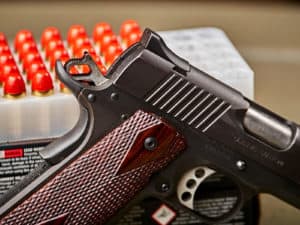
In contrast to striker fired guns, this hammer fired, single action 1911 uses the mass of a hammer to send a separate firing pin into the primer to ignite the round.
Action
Every gun has an action. The action is the set of parts that load the firearm, lock the ammunition into the chamber, fire the round, extract and then eject the spent casing. When we narrow the field from all handguns to semi-autos, the actions become incredibly similar.
Almost all semi-auto handguns load the ammunition with the slide scooping the round from a magazine. Most lock the cartridge into the chamber in relatively similar ways. Most guns use a common method of extracting and ejecting the spent casing. Even where a handgun completes one of these tasks differently there is very little impact on the experience of shooting the gun.
There is that one task of the action that can be different and often has an impact on the shooter and the shot. The mechanism that actually fires the gun. It’s this difference in guns that makes the question, “What is a striker fired handgun?” so valid.
The Action of a Striker Fired Handgun
When a striker fired pistol does its thing, it does it in a very simple and linear fashion. When the trigger is pressed, the striker moves slightly to the rear as internal safeties are defeated. Then the striker moves forward under the assistance of the spring that was compressed when loading the gun. The striker, which also acts as a firing pin, caries its mass into the primer. Energy from the detonation of the cartridge forces the bullet through the barrel and down range. As the bullet leaves, that energy also forces the slide to the rear. The spent casing is extracted from the chamber and ejected. As the slide moves forward the energy is used to load another round into the chamber and compress the striker spring. The striker spring is held safely to the rear until released by the press of the trigger.
A Time-Line of the Striker Fired Action Firearms
- 1880 Daniel LeFever manufactured the first hammerless firearm, a shotgun.
- 1883 LeFever’s action transitioned from a side cocking design to an automatic (what we call today a semi-auto).
- 1893 German Hugo Borchadrt introduced the “toggle-lock” action Borchardt C-93 pistol, which is likely the first striker fired handgun.
- 1970 Heckler & Koch VP70 Volkspistole (the people’s pistol), the first striker-fired pistol with a polymer frame.
- 1982 the GLOCK 17 was introduced.
- Today modern striker fired handguns dominate the market when it comes to duty and defensive handguns.
What Makes a Striker Fired Handgun Stand Out?
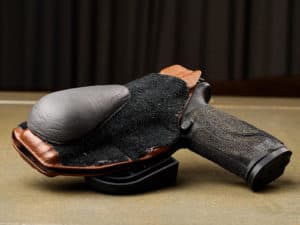
My S&W M&P 9 Full Size is my concealed carry handgun. It isn’t glamorous. Instead it is a tool and it looks like a tool. It lives inside a Dark Star Gear Orion Holster with its striker fire action ready to do work.
The answer for lots of folks might be, “Nothing!”
From the factory your typical pistol with a striker fired action is plain Jane. I think of the typical Glock like an entry-level Jeep Wrangler. Not much to look at, but more capable than you would expect.
Like a Wrangler, a striker fired handgun isn’t necessarily the best gun for every application. I’m not going to spend time on a racing oval with a Jeep. It’s also not the choice for racing in the desert. But, that Jeep will get you just about anywhere you need to go in just about any conditions.
A Glock 19 or M&P 9 are going to do the same thing. They can get about any job done that needs to get done with a handgun. You might not be the fastest or the best looking while doing it, but the job will get done.
There are plenty of choices out there for shooters to make when they select their next handgun, and pistols that are striker fired are one of the most popular choices. So there must be something that makes these guns attractive.
Striker fired guns aren’t fancy and they aren’t glamorous. What they are is practical.
I think one word best summarizes what makes striker fired guns stand out compared to other types of handgun actions:
Efficiency
When you compare a striker fired gun to traditional double action, double action only, and single action handguns, it is the simplicity that helps them shine for shooters of all ability levels and over a wide variety of applications.
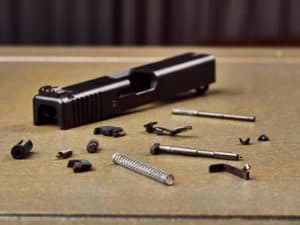
The heart of a Glock 17 is its striker fired action. The striker is held under the spring tension until the safeties are defeated and the trigger is pressed.
Parts
A handgun with a striker fired action is efficient because it tends to have fewer parts than guns that are hammer fired. The striker takes the place of both the firing pin and the hammer. Eliminating the hammer and its associated parts reduces the number of parts and the gun’s complexity. This makes disassembly and reassembly simpler and leads to greater reliability and longer times between necessary service.
The design of striker fired handguns allows for a reduction in the number of controls as well as internal parts. Striker fired guns don’t have decocking levers, as they are intended to be carried safely with the striker under spring tension. Most striker fired guns also delete the manual thumb safety, which again means fewer parts and simpler operation. Keep in mind the lack of a thumb safety doesn’t mean striker fired guns don’t have safeties. They do. Both internal and external safeties prevent the gun from firing unless the trigger is pressed.
Low Bore Axis
In a striker fired action, the striker is pushed to the rear then placed and held under spring tension when the gun is loaded. The operation of the action is linear in nature. In comparison, when the hammer of a TDA, DA, or SA gun operates it is forced to swing its mass in an arc. This generally requires that the bore of the gun is raised farther above the hand.
From an efficiency standpoint, a design difference tends to increase the leverage that acts on the hand when the gun recoils.
The typical striker fired gun reduces this leverage and reduces felt recoil. Less felt recoil can result in faster follow up shots, as the sights lift from the target less under recoil and return to the target more quickly.
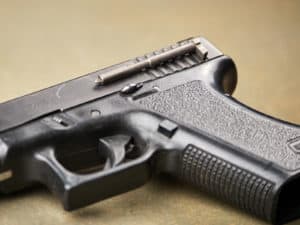
Unlike hammer fired actions, the striker from this Gen 2 Glock 17 operates in a straight line which helps keep the barrel of the gun close to the top of the hand. This in turn reduces the felt recoil.
Trigger Press
The triggers of striker fired guns don’t tend towards glamorous. But they are shootable. When compared to double action and traditional double action guns, most striker fired guns have very usable triggers straight out of the box. Striker fired guns have triggers with a shorter overall travel and a trigger weight that is appropriate for duty or concealed carry and easy to learn to shoot well.
When compared to a decent single action trigger, a stock trigger on a striker fired pistol falls behind, but not by much. Most folks, when they consider the whole package and the efficiency that comes with it, are perfectly satisfied with the trigger in their modern striker fired handgun.
Final Thoughts
Handguns fill different needs for different people. For some, a handgun is a precision tool used for hunting or trouncing friends on the range. For others, it is a racing machine designed to deliver accuracy at blistering speed. Another group of people look to handguns as a means to complete a collection of finely crafted machines.
For me, a handgun is a tool. A tool to protect myself and to defend my family.
My guns need to take a beating and keep running. My carry piece needs to devour whatever ammo I stuff into it, especially hollow points. It needs to be simple to operate and maintain. I need my handgun to be shootable.
So you ask, “What is a striker fired handgun?”
I gave you the technical answer above, but maybe it makes sense for me to share my personal thoughts:
A striker fired handgun is my personal protection tool of choice. It is reliable and simple. It is easy to shoot and easy to maintain. I count on it with confidence every day.
I suppose a textbook answer is nice and some gunwriter’s opinion could be meaningful. What’s probably more important are your thoughts.
So, in your opinion, what is a striker fired handgun? Let us know below in the comments.

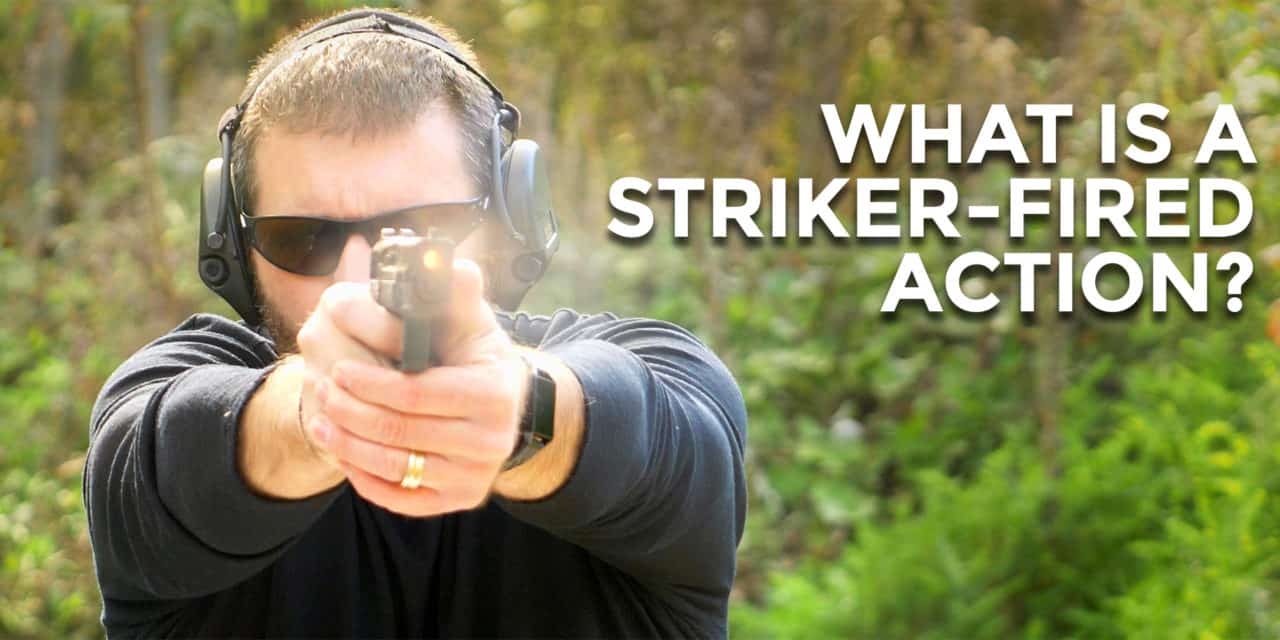

Interesting! Where is the rebuttal from a hammer-firing pin shooter?
You might make a hammer fired gun into a better target gun. Today, the striker fired gun offers a better set of compromises for concealed carry.
In my opinion, a striker fired handgun is simply a hammerless single-action pistol.
I don’t know Glock from a rock, but I’ve moved from a .45ACP Officer size steel frame M1911 and a .380ACP micro size aluminum frame M1911 to an M&P Compact M2.0 in 9mm. Despite some differences in the firing mechanisms, I don’t perceive “striker” as different from “hammerless” in any practical way.
1) All three pistols have a bore axis within a millimeter or two of one inch above my thumb web — not different at all. I feel no difference between the inline ounce of a striker sliding and the swinging ounce of a hammer arc.
2) I’ve replaced mag springs on the .45 after forty years, and the recoil spring of the .380 after a few thousand rounds. I have never fully disassembled any gun except from curiosity.
3) All three pistols have a manual safety as an extra barrier to unintended discharge during unholstering, reholstering, and some stages of administrative handling — eliminating the safety is not a “striker” feature, it’s a belief system. It is my belief that a single-action with no thumb safety is just as safe (or unsafe, if you prefer) as a striker-fired gun having similar passive safety features.
4) The stock M&P trigger has a LOT of pre-travel, which seems mostly about getting the trigger “safety dongle” out of the way, followed by a firm wall and movement-free let-off. In practice, that works like a long, soft first stage of a two-stage trigger. The M1911s have a similar feel, but only a couple mm of pre-travel. I’d prefer a travel distance half-way between, but that is also not a “striker” feature — it’s a trigger design.
Any revolver is different from any pistol. The various double-action variants differ from any single-action. Not every single-action pistol is a M1911, and not every striker-fired pistol is a Glock. But for me, “striker” = “hammerless SA”.
You answered this question better in the first sentence than the writer did in that word cloud he created.
I AGREE 100%. FIRST SENTENCE SAYS IT ALL. SAO. SINGLE ACTION ONLY. BUT A SAFER, SLIGHTLY HEAVIER TRIGGER THAN SA HAMMER GUN. MY CONCERN IS CARRYING A CHAMBERED ROUND ALL DAY OR LEAVING A CHAMBERED ROUND IN A STRIKER GUN OVER TIME WHICH IS ESSENTIALLY COCKED SA. YOU CAN DO THIS NO PROBLEM WITH A HAMMER GUN IN DA WITH ZERO SPRING TENSION. I KNOW PEOPLE CARRY A STRIKER THIS WAY AND ITS SAFE EVEN WHEN DROPPED, WONT FIRE UNTIL THE TRIGGER IS PRESSED ETC… BUT WONT LEAVING THE STRIKER SPRING UNDER TENSION/COCKED MOST OF THE TIME EVENTUALLY FATIGUE THE SPRING OVER TIME? SEEMS THE BEST WAY IS TO CARRY A STRIKER IS UNCHAMBERED. THIS RENDERS THE GUN TOTALLY SAFE WITH NO SPRING TENSION. BUT YOU BETTER BE READY TO RACK THE SLIDE IF DANGER COMES SO THIS DOES SLOW YOUR DRAW WHICH IS ALSO WHY PEOPLE CARRY A CHAMBERED ROUND REGARDLESS. FOR ME ITS JUST HARD TO CARRY A CHAMBERED SA GUN IN YOUR PANTS KNOWING THE STRIKER SPRING IS COCKED WHICH IS WHY A GOOD HOLSTER IS CRITICAL. KIND OF LIKE A 1911 IN SA WITH THE SAFETY ON.
By custom, striker guns are presumed to have heavier triggers than SA hammer guns — but I think that’s mostly a design or manufacturing choice. A 1911 can have a heavier trigger and a striker can be relatively light. I don’t have a trigger pull gauge, but I wouldn’t say my M&P and 1911s feel like particularly different weights — they differ a lot in the amount of pre-travel. The amount of extra “work” being done by a striker trigger is way less than a traditional DA. AFAIK a striker firing spring is always compressed except when decocked — just the same as a hammer-fired single action. My understanding is that springs fatigue by being loaded and unloaded — not by remaining loaded. I don’t hear about “wearing out” firing springs like I do the recoil springs, but I suppose it will eventually happen. IMHO a decocked or unchambered handgun is not a tool prepared for defensive use. A traditional DA/SA or DAO is considerably better than having to chamber a round by manual slide operation, but I will carry Condition One with a thumb safety — whether hammer or striker fired.
According to the description :”When the trigger is pressed, the striker moves slightly to the rear as internal safeties are defeated. Then the striker moves forward under the assistance of the spring that was compressed when loading the gun. The striker, which also acts as a firing pin, caries its mass into the primer.” this says that the striker (firing pin) is always cocked from the slide being racked/activated-after firing. ergo, the pistol is always COCKED. Several videos I have seen depict this same sequence. A good friend, showed me a video-that the GLOCK actually cocks the firing spring as the trigger is pulled. and that the firing spring is not always under tension. Which is it? I have regarded striker fired as inherently dangerous from being always cocked and only the grip safety ( if one) or the trigger safety keeps it from firing if jarred from a drop?
I think “drop-safe” design is pretty much standard in all reputable modern handguns.
At least in handguns intended to be carried cocked, that typically is a mechanical disconnect between the main firing spring and the striker/firing pin and/or hammer — to prevent the one from being activated by the other. The disconnection means the gun cannot fire (e.g. jarred by a drop or blow to the hammer) until the trigger is actually moved to the rear. Until the trigger is pushed, the gun can’t become “uncocked”, i.e. fire. Other safety mechanisms (thumb safety, grip safety, trigger “dongle”) are intended to block unintended trigger movement, but “drop-safe” is buried inside the gun and is always on until the trigger releases it.
There is also a spring which keeps the firing pin/striker from sticking out of the bolt face except during the instant it has been thrown forward by force of the firing mechanism.
When it comes to unintended discharge, worry more about the trigger than dropping.
SAO. it is single action only. once you pull the slide on a striker gun it is always cocked until you pull the trigger. its the only way to release the spring tension. so always CYC. clear your chamber. this is the way of the striker. if this does not appeal to you get a sa/da hammer gun with a decocker.
indeed.. it is why I carry DA/SA hammer fired pistols
well according to that video, the trigger pull is also compressing the firing pin spring which would make it a double action only and a safer, uncocked gun with a chambered round. So i can understand your question now. Seems this would also make for a heavier trigger at least in glock. thanks for the vid, but now im confused bc tyler said it was single action only.
from the video0 it confirms that the firing pin is always under tension- MORE so when the trigger is pulled- but because it requires a firing pin block AND another retainer at the rear- I do not like Striker fired guns. Had a few go bang-click-click-bang-click -click… never had that with hammer fired pistols or revolvers.
yeah i hear ya. i still have my beretta px4 but i actually might sell it to a friend. nice safe gun in da and even more so with the safety decocker. but alas, i am going the way of the striker in all my handguns. ill prob get a mossberg mc2c to replace it as my carry. then i also have an s&w sd9ve and m&p2.0. none with thumb safeties. still it would be hard for me to conceal carry with a chambered round in these guns without a manual thumb safety bc of what you just said. i would if i had to but with a hard owb holster only . s&w does offer thumb safeties on their guns but the more popular trend of strikers seems to be no manual safety these days. glocks have never had thumb safeties
https://www.youtube.com/watch?v=V2RDitgCaD0